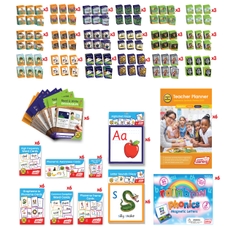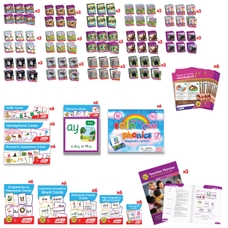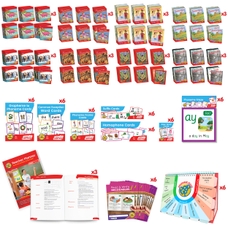Junior Learning Classroom Kit - Year 1
Junior Learning Classroom Kit - Year 1
Product code: CP00053028
Product Description
The complete phonics solution for your Year 1 classroom. Covers alternative vowel sounds, sound families and an introduction to suffixes. The Teacher Planner sets out all the lessons for the year, and a handy calendar presents these according to the school terms. There is also a number of revision lessons included as preparation for the Phonics Screening Check (PSC).
The kit itself includes 6 x 168 different decodable reader titles. These are the various genres of fiction, non-fiction, science and HiLo so there are plenty of topics to choose for the children. Each decodable clearly presents the progression in the front of the reader, along with and tricky or common exception words that are used in the text. Furthermore, for the Sound Family decodables, there is a phoneme progression and a table that shows words that are included in the text that make the target phoneme but are grouped according to the different spellings of that phoneme. The Fix Its range of decodables does the same thing, but instead uses suffixes and embeds these into the text so that children can practise these spelling formations in their reading. Finally, six sets of 12 Read and Write Decodables are included to support the transition of decoding skills into writing.
There are a number of supplementary resources included in the kit to support learning and these are references in the Teacher Planner. These include: a Phoneme Frieze, Phonemic Awareness cards, Grapheme to Phoneme cards, Phoneme Frame cards, Common Exception Word cards, High Frequency Word cards, Alien Word cards, Suffix cards, Homophone cards and Rainbow Phonic magnetic letters.
The phoneme frieze is included for classroom decoration and visually displays with various Sound Families taught in Year 1.
The Rainbow Phonic magnetic letters are colour-coded around their phonemes and are also joined to represent digraphs (and trigraphs) as one unit of sound. Every daily lesson in the Teacher Planner has a table with quick reference to words that can be built at that stage according to the progression.
The GPC cards (grapheme to phoneme cards) are central to the programme and these provide an easy to remember mnemonic so that children can grasp a newly introduced letter sound and match these with other cards containing graphemes that also make the target sound.
Common exception word cards provide examples of the common exception words that run parallel to the progression. Unique to this programme are sound speech marks that help children correctly identify the tricky part of the word. There are also high frequency word cards that don’t contain tricky elements and phoneme frame cards for daily practice. Both card sets have a write and wipe surface so that they can also be used for handwriting practice.Alien word cards are provided for that a nonsense word can be introduced daily (according to the progression) and decoded. These cards can also be used alongside the various assessments provided in the planner and throughout the programme.
Finally, Homophone cards provide examples of words where the sounds are the same but the spellings are different. This enables children to see how a grapheme with a common sound can change the meaning of a word.
Kit components:
- 1x JL697 Teacher Planner Year 1
- 6x JL384 Letters & Sounds Phase 5 Set 1 Fiction (12 different titles)
- 6x BB109 Letters & Sounds Phase 5 Set 2 Fiction (12 different titles)
- 6x JL390 Letters & Sounds Phase 5 Set 1 Non-Fiction (12 different titles)
- 6x BB115 Letters & Sounds Phase 5 Set 2 Non-Fiction (12 different titles)
- 6x BB103 Science Decodables Phase 5 (12 different titles)
- 6x BB139 The Beanies Hi-Lo Phase 5 (12 different titles)
- 6x BB142 Sound Families Long Vowel Fiction Phase 5.5 (12 different titles)
- 6x BB143 Sound Families Consonants Fiction Phase 5.5 (12 different titles)
- 6x BB144 Sound Families R-controlled Fiction Phase 5.5 (12 different titles)
- 6x BB146 Sound Families Long Vowels Non-Fiction Phase 5.5 (12 different titles)
- 6x BB147 Sound Families Consonants Non-Fiction Phase 5.5 (12 different titles)
- 6x BB148 Sound Families R-controlled Non-Fiction Phase 5.5 (12 different titles)
- 6x BB145 Fix Its Suffixes Fiction Phase 6 (12 different titles)
- 6x BB149 Fix Its Suffixes Non-Fiction Phase 6 (12 different titles)
- 3x JL695 Read & Write Decodables Set B (12 different titles)
- 3x JL691 Phonemic Awareness Cards (89 cards)
- 3x JL686 Grapheme to Phoneme Cards (152 cards)
- 3x JL687 Common Exception Word Cards (111 cards)
- 3x JL688 High Frequency Word Cards (52 cards)
- 3x JL689 Phoneme Frame Cards (161 cards)
- 3x JL692 Alien Word Cards (147 cards)
- 3x JL693 Homophone Cards (69 cards)
- 3x JL694 Suffix Cards (27 cards)3x JL710 Phoneme Frieze (70 tiles)
- 3x JL194 Rainbow Phonics Magnetic Letters (84 magnetic letters and whiteboard)
Ideal to use in intervention sessions or booster groups
Further Information
- Age Recommended from
- 6 Years
- Age Recommended to
- 12 Years
- Age Suitable from
- 3 Years
- Brand
- Junior Learning
- Key Stage
- Key Stage 1
- Publisher
- Junior Learning
Documents
The complete phonics solution for your Year 1 classroom. Covers alternative vowel sounds, sound families and an introduction to suffixes. The Teacher Planner sets out all the lessons for the year, and a handy calendar presents these according to the school terms. There is also a number of revision lessons included as preparation for the Phonics Screening Check (PSC).
The kit itself includes 6 x 168 different decodable reader titles. These are the various genres of fiction, non-fiction, science and HiLo so there are plenty of topics to choose for the children. Each decodable clearly presents the progression in the front of the reader, along with and tricky or common exception words that are used in the text. Furthermore, for the Sound Family decodables, there is a phoneme progression and a table that shows words that are included in the text that make the target phoneme but are grouped according to the different spellings of that phoneme. The Fix Its range of decodables does the same thing, but instead uses suffixes and embeds these into the text so that children can practise these spelling formations in their reading. Finally, six sets of 12 Read and Write Decodables are included to support the transition of decoding skills into writing.
There are a number of supplementary resources included in the kit to support learning and these are references in the Teacher Planner. These include: a Phoneme Frieze, Phonemic Awareness cards, Grapheme to Phoneme cards, Phoneme Frame cards, Common Exception Word cards, High Frequency Word cards, Alien Word cards, Suffix cards, Homophone cards and Rainbow Phonic magnetic letters.
The phoneme frieze is included for classroom decoration and visually displays with various Sound Families taught in Year 1.
The Rainbow Phonic magnetic letters are colour-coded around their phonemes and are also joined to represent digraphs (and trigraphs) as one unit of sound. Every daily lesson in the Teacher Planner has a table with quick reference to words that can be built at that stage according to the progression.
The GPC cards (grapheme to phoneme cards) are central to the programme and these provide an easy to remember mnemonic so that children can grasp a newly introduced letter sound and match these with other cards containing graphemes that also make the target sound.
Common exception word cards provide examples of the common exception words that run parallel to the progression. Unique to this programme are sound speech marks that help children correctly identify the tricky part of the word. There are also high frequency word cards that don’t contain tricky elements and phoneme frame cards for daily practice. Both card sets have a write and wipe surface so that they can also be used for handwriting practice.Alien word cards are provided for that a nonsense word can be introduced daily (according to the progression) and decoded. These cards can also be used alongside the various assessments provided in the planner and throughout the programme.
Finally, Homophone cards provide examples of words where the sounds are the same but the spellings are different. This enables children to see how a grapheme with a common sound can change the meaning of a word.
Kit components:
- 1x JL697 Teacher Planner Year 1
- 6x JL384 Letters & Sounds Phase 5 Set 1 Fiction (12 different titles)
- 6x BB109 Letters & Sounds Phase 5 Set 2 Fiction (12 different titles)
- 6x JL390 Letters & Sounds Phase 5 Set 1 Non-Fiction (12 different titles)
- 6x BB115 Letters & Sounds Phase 5 Set 2 Non-Fiction (12 different titles)
- 6x BB103 Science Decodables Phase 5 (12 different titles)
- 6x BB139 The Beanies Hi-Lo Phase 5 (12 different titles)
- 6x BB142 Sound Families Long Vowel Fiction Phase 5.5 (12 different titles)
- 6x BB143 Sound Families Consonants Fiction Phase 5.5 (12 different titles)
- 6x BB144 Sound Families R-controlled Fiction Phase 5.5 (12 different titles)
- 6x BB146 Sound Families Long Vowels Non-Fiction Phase 5.5 (12 different titles)
- 6x BB147 Sound Families Consonants Non-Fiction Phase 5.5 (12 different titles)
- 6x BB148 Sound Families R-controlled Non-Fiction Phase 5.5 (12 different titles)
- 6x BB145 Fix Its Suffixes Fiction Phase 6 (12 different titles)
- 6x BB149 Fix Its Suffixes Non-Fiction Phase 6 (12 different titles)
- 3x JL695 Read & Write Decodables Set B (12 different titles)
- 3x JL691 Phonemic Awareness Cards (89 cards)
- 3x JL686 Grapheme to Phoneme Cards (152 cards)
- 3x JL687 Common Exception Word Cards (111 cards)
- 3x JL688 High Frequency Word Cards (52 cards)
- 3x JL689 Phoneme Frame Cards (161 cards)
- 3x JL692 Alien Word Cards (147 cards)
- 3x JL693 Homophone Cards (69 cards)
- 3x JL694 Suffix Cards (27 cards)3x JL710 Phoneme Frieze (70 tiles)
- 3x JL194 Rainbow Phonics Magnetic Letters (84 magnetic letters and whiteboard)
Ideal to use in intervention sessions or booster groups
Further Information
- Age Recommended from
- 6 Years
- Age Recommended to
- 12 Years
- Age Suitable from
- 3 Years
- Brand
- Junior Learning
- Key Stage
- Key Stage 1
- Publisher
- Junior Learning


